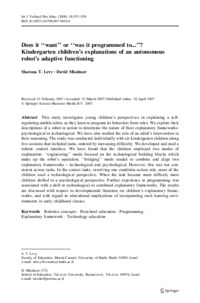 Zusammenfassungen
Zusammenfassungen
This study investigates young children’s perspectives in explaining a self-regulating mobile robot, as they learn to program its behaviors from rules. We explore their descriptions of a robot in action to determine the nature of their explanatory frameworks: psychological or technological. We have also studied the role of an adult’s intervention in their reasoning. The study was conducted individually with six kindergarten children along five sessions that included tasks, ordered by increasing difficulty. We developed and used a robotic control interface. We have found that the children employed two modes of explanation: “engineering” mode focused on the technological building blocks which make up the robot’s operation; “bridging” mode tended to combine and align two explanatory frameworks – technological and psychological. However, this was not consistent across tasks. In the easiest tasks, involving one condition–action rule, most of the children used a technological perspective. When the task became more difficult, most children shifted to a psychological perspective. Further experience in programming was associated with a shift to technological or combined explanatory frameworks. The results are discussed with respect to developmental literature on children’s explanatory frameworks, and with regard to educational implications of incorporating such learning environments in early childhood classes.
Von Sharona T. Levy, David Mioduser im Text Does it «want» or «was it programmed to...»? (2008)  Dieser wissenschaftliche Zeitschriftenartikel erwähnt ...
Dieser wissenschaftliche Zeitschriftenartikel erwähnt ...
 Personen KB IB clear | Valentin Braitenberg , John Seely Brown , Allan Collins , P. Duguid , Idit Harel , Ken Kahn , Seymour Papert , Sherry Turkle , Lew Semjonowitsch Vygotsky , John Broadus Watson | |||||||||||||||||||||||||||||||||||||||||||||||||||||||||||||||
 Begriffe KB IB clear |  Kinder Kinder children
, children
,  Kindergarten
, Kindergarten
,  Programmieren Programmieren programming
, programming
,  Roboter Roboter robot
, Zone of Proximal Development robot
, Zone of Proximal Development
| |||||||||||||||||||||||||||||||||||||||||||||||||||||||||||||||
 Bücher |
| |||||||||||||||||||||||||||||||||||||||||||||||||||||||||||||||
 Texte |
|
 Dieser wissenschaftliche Zeitschriftenartikel erwähnt vermutlich nicht ...
Dieser wissenschaftliche Zeitschriftenartikel erwähnt vermutlich nicht ... 
 Nicht erwähnte Begriffe | Eltern |
 Tagcloud
Tagcloud
 Zitationsgraph
Zitationsgraph
 Zitationsgraph (Beta-Test mit vis.js)
Zitationsgraph (Beta-Test mit vis.js)
 Zeitleiste
Zeitleiste
 1 Erwähnungen
1 Erwähnungen 
- Frühe informatische Bildung - Ziele und Gelingensbedingungen für den Elementar- und Primarbereich - Wissenschaftliche Untersuchungen zur Arbeit der Stiftung "Haus der kleinen Forscher" (Nadine Bergner, Hilde Köster, Johannes Magenheim, Kathrin Müller, Ralf Romeike, Ulrik Schroeder, Carsten Schulte) (2018)


 Volltext dieses Dokuments
Volltext dieses Dokuments
 |  Does it «want» or «was it programmed to...»?: Artikel als Volltext ( Does it «want» or «was it programmed to...»?: Artikel als Volltext ( : :  , 313 kByte; , 313 kByte;  : :  ) ) |
 Anderswo suchen
Anderswo suchen 
 Beat und dieser wissenschaftliche Zeitschriftenartikel
Beat und dieser wissenschaftliche Zeitschriftenartikel
Beat hat Dieser wissenschaftliche Zeitschriftenartikel während seiner Zeit am Institut für Medien und Schule (IMS) ins Biblionetz aufgenommen. Beat besitzt kein physisches, aber ein digitales Exemplar. Eine digitale Version ist auf dem Internet verfügbar (s.o.). Es gibt bisher nur wenige Objekte im Biblionetz, die dieses Werk zitieren.

















 Biblionetz-History
Biblionetz-History